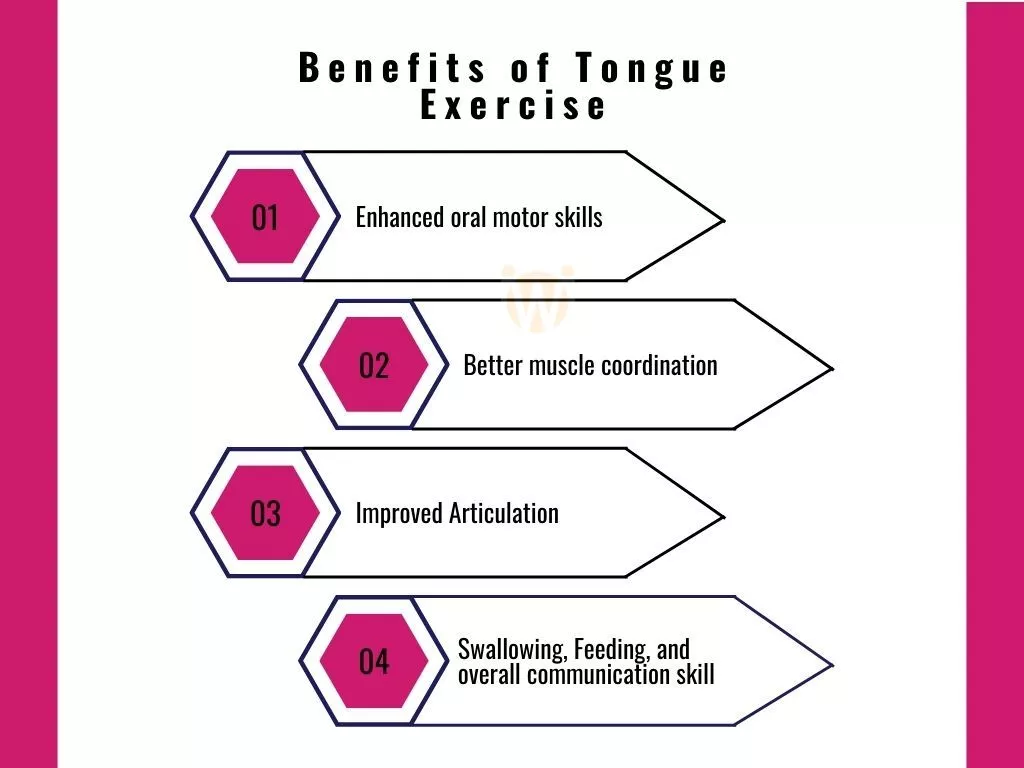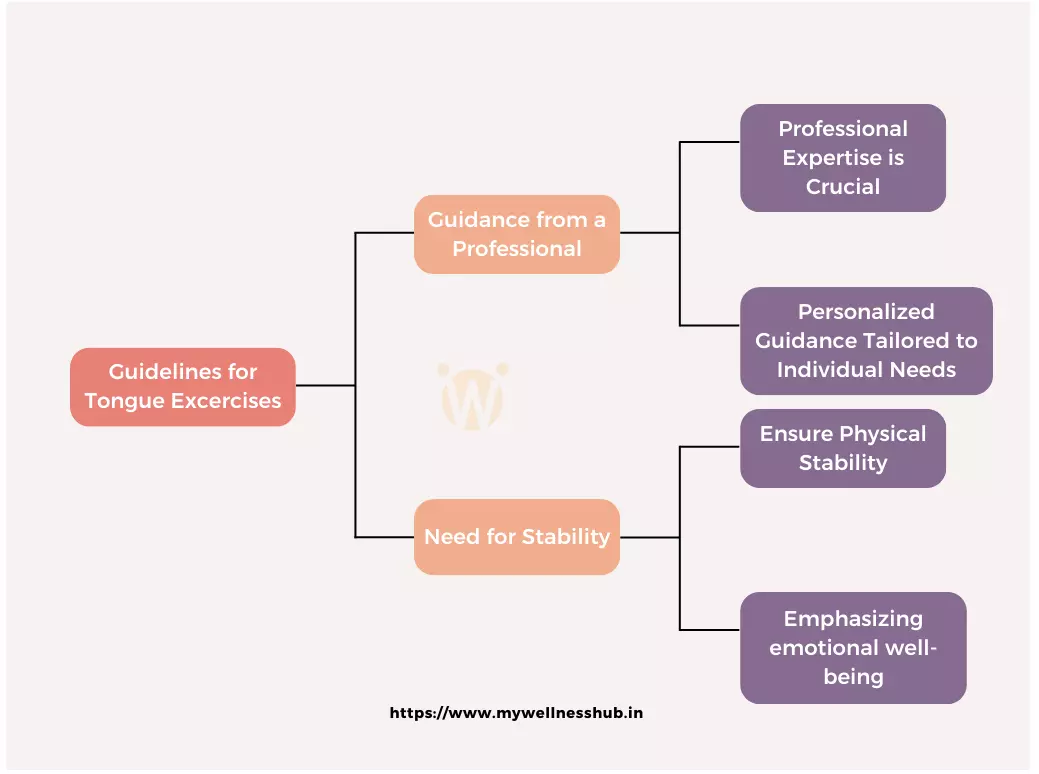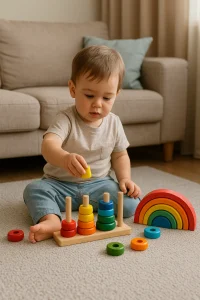Oral Motor Exercises: Tongue Exercises for Confident Speech
Last Updated: November 21, 2023
The journey of speech and language development of an individual involves various aspects such as articulation, pronunciation, and the production of various speech sounds. Along with all the other parts of the mouth and the control of airflow, the movement of the tongue and its involvement in producing certain speech sounds is of much importance. Our tongue is an essential and flexible muscle part that plays a vital role in speech production. As a part of speech and language development in individuals, tongue exercises are very crucial. Tongue exercises help strengthen the tongue muscles, improving articulation and overall oral motor skills.

Why are tongue exercises necessary?
Tongue exercises help in developing coordination and control, which is necessary for the production of a wide range of speech sounds and words.
Also read: Speech Clarity: The Key Goals of Oral Motor Exercises
Articulation:
The tongue has a major role to play in articulating speech sounds. There are certain speech sounds that require precise tongue moments, especially alveolar sounds such as /t/, /d/, /n/, and lingual sounds such as /l/, and/r/. Strengthening the tongue muscles can help in producing clearer and more accurate articulation.
Oral motor skills:
Strengthening the tongue muscles would help in the development of oral motor skills that are essential for various speech-related activities. The skills such as speaking, eating, swallowing, and chewing would come under oral motor skills.
Muscle coordination:
Practicing tongue exercises can bring good muscle control, which helps in better coordination during speech production. Such coordination can produce precise formation of speech sounds. Tongue exercises can help in a smooth transition between different speech sounds and words.
Swallowing and Feeding:
Swallowing and feeding abilities of an individual are closely related to speech and language development. Effective tongue exercises can promote these abilities. Strengthening tongue muscles can lead to better swallowing and feeding, which, in turn, can promote overall oral health and development.
Overall Communication Skills:
Practicing tongue exercises can enhance the flexibility and strength of your child’s tongue muscles. Making them do these exercises can help them improve their articulation and speech control and enhance oral motor skills. This boosts their self-confidence and provides effective interactions and better social engagement.
For individuals having speech and language difficulties, practicing such exercises under the guidance of a speech and language pathologist or a healthcare professional specializing in speech therapy can benefit well. They provide custom-tailored therapy plans and targeted exercises with scientifically proven techniques for individuals according to their needs.

Techniques for improved tongue movements:
Here are different techniques that help in the improvement of tongue movement for speech development.
Tongue lateralization exercises:
These exercises create awareness of the lateral movements of the tongue. They strengthen and tone the muscles for tongue lateralization.
Guidelines for these exercises

- While working with these tongue movements, the child’s head and jaw should remain stable.
- While the child’s tongue moves to the side, the head shouldn’t follow it. Your child’s head should not tilt back with rear tongue elevation.
- To reduce extraneous movements, place your hand on the back or side of the child’s head.
- Perform the following exercises at home with your child at least once a day for enhanced speech improvement.

Tongue exercises
You can model these exercises for your child to make him/her do so. Make the child do these exercises by following the instructions carefully.
Tongue side to side:
Make your child’s tongue tip move to the left side of the mouth and make him hold there for 3 to 5 seconds. Now make him move his tongue tip to the right side of the mouth and hold there for 3 to 5 seconds.
In case the child is unable to do so, hold the tongue with a gauge and move. Afterward, let him or her practice gradually.
Later, ask the child to protrude the tongue and move it from side to side. Make sure that the tongue does not touch the lips.
Tongue brush:
Have your child stick out his or her tongue. Using a toothbrush, gently brush the left side of the tongue from front to back with three quick and firm strokes. Then, brush the right side of the tongue in the same way. Repeat each set three times. This stroking will draw the tongue to the side that you are stroking. An increased awareness of the sides of the tongue is possible with this exercise.
Side tongue push:
Ask your child to stick the tongue out. Hold the flat side of a tongue depressor or a craft stick or toothbrush against the left side of the tongue. Have your child push the tongue depressor or craft stick to the left side with the side of his tongue. Repeat the same steps for the right side of the tongue, too. Repeat this five times.
Liquorice Leap:
Take a half-inch liquorice or chocolate piece and place this in the right cheek cavity of your child’s mouth. Then have the child use his/her tongue to scope the liquorice or chocolate piece from one side to the other side of his/her mouth while keeping the mouth open. Have your child’s jaw and head movement to a minimum by stabilizing with your hand, if necessary. Repeat this twice, alternating sides while placing liquorice or Chocolate piece.
Squirrel cheeks:
Place your index fingers on your child’s cheeks. Have your child open his/her mouth and push the tongue into the cheek against your finger. In case your child’s jaw moves from side to side, stabilize it with your middle fingers and thumbs. You may start with one cheek and then do with the other. After doing this successfully, have the child repeat this exercise with the lips closed. Repeat this five times.
Exercises for the back of the tongue:
These exercises strengthen and tone the tongue muscles for rear tongue elevation and to elevate the back of the tongue to produce /k/ and /g/.
Tongue back:
To strengthen the back of the tongue, have your child move the tongue backward and downward in a circular motion, by lightly scratching the back of the throat with the tongue tip.
Toothette pump for Tongue retraction:
This is a resistance exercise. You may have your child open his or her mouth and anchor the tongue tip behind the bottom teeth. Using the flat end of a toothette, push against her tongue blade. Now, have the child say /k/ repeatedly. Stabilize the jaw of your child’s mouth with your hand, if necessary. Hold this for 1 to 3 seconds. Relax and repeat it three to five times.
Gargling:
Ask your child to tilt the head back and as if looking at the ceiling. Now, ask the child to make a gargling sound. Older children can do the same using a small sip of water. Repeat this five times.
You can ask the child to make a /k/ sound in this position as gravity pulls the tongue back. Please repeat the same five times.
Coughing and Yawning:
Along with gargling, coughing and yawning would also stimulate rear tongue elevation.
Tongue Sucking:
Make your child suck his/her tongue to the palate and pull it back to release. This makes a popping sound, engaging the kid while it helps the tongue strengthen.
Tongue tip elevation exercises:
These exercises increase the tone and strength of the tongue tip. They would also associate the tongue tip elevation with tongue tip sounds like /t/, /d/, and /l/. Tongue tip exercises improve flexibility for rapid movement in words, phrases, and sentences.
Important note:
Your child should be able to lateralize the tongue before tongue tip elevation can be achieved. If the child cannot lateralize, go back to the tongue lateralization and backing. Repeat the tongue lateralization exercises.
Tongue Extension:
Ask your child to stick out the tongue and hold it steady for 1 to 2 seconds initially. Gradually increase this time duration to 4 to 5 seconds. Then, make the child relax and repeat this 3 to 5 times.
Later, you can practice by asking the child to touch any of his favorite foods with his tongue tip by sticking the tongue out. In case the child is unable to do this, use a gauge and gently pull the tongue out and move it from left to right slowly. Let the child feel the movements of the tongue. Hold the tongue on each side for 2 to 3 seconds. This tongue-holding will strengthen the tongue muscles.
Tongue up and down:
Make your child open his mouth and let his tongue tip touch the upper lip and the lower lip, respectively. Relax and repeat five times.
Tongue stroke:
Make a child stick out his or her tongue. Use a tongue depressor or a craft stick and stroke each side of the child’s tongue with three quick and firm strokes from back to front. Relax and repeat 5 times.
Palate Lick:
Using the craft stick, put a dab of peanut butter on the child’s alveolar ridge and have the child lick it off with tongue. Let this movement occur in the front and back fashion. You can substitute cheese/honey/jam or any food with a similar texture.
Tongue-tip Hold:
Put a dab of peanut butter on the child’s alveolar ridge. Keeping the mouth open, make the child touch the peanut butter with the tip of his tongue and hold it for 3 to 5 seconds.
Tongue-tip Push:
Take a tongue depressor and hold it against the child’s closed lips. Make your child push the tongue through the lips and push this tongue depressor away. Make sure the child opens his/her mouth only wide enough for the tongue to push through. Apply gentle resistance against the tongue.
In case your child’s tongue collapses or folds, reduce the resistance. If your child’s tongue gains strength, apply greater resistance. Relax and repeat this five times. You may also use a toothbrush in place of tongue depressor.
Dental floss Curl-ups:
Hold a dental floss holder before your child’s mouth. Have the child put the tip of his/her tongue through the dental floss holder and curl the tip up around the floss. You can now ask your child to open the mouth wide and pull the floss into the mouth while you apply gentle resistance. Be careful not to release your grip. Repeat this five times.
Tongue Bowl:
For this exercise, have your child open the mouth, relax his/her tongue, and rest on its bottom lip. Place the tip of a craft stick behind your child’s tongue tip and run it down the center line of his/her tongue about halfway back. You should be careful not to cause a gag reflex. Your child’s tongue will side and the tip will call up, creating a bowl effect. You may make your child look in the mirror and repeat this exercise three times.
Instead of a craft stick, you may use a toothbrush and place its bristles behind the tongue tip. Once your child gets used to it, you may ask the child to try making a tongue bowl on his own without the help of a craft stick.
Lah Sound:
To try this experiment, take a tongue depressor and place it between the child’s right molars so that the mouth is open until the width of the tongue depressor. Have a child bite down gently on the tongue depressor and repeat the syllables “lah, lah, lah” while not allowing the tongue depressor to move. If the child’s tongue protrudes, encourage to lift the tip of the tongue to the rest spot.
Make the child repeat three sets of three syllables “lah, lah, lah”. Then, have the child repeat the same without using a tongue depressor. You can try the same experiment using a toothbrush, too.
All these tongue exercises help in strengthening the tongue muscles, which foster the controlling the tongue movements during speech. Various speech sounds and words can be learned in a perfect way when the tongue muscles help that to happen. This way, the articulation errors of your child will be soon corrected and the pronunciation will improve. Speaking confidently without errors can help your child express his/her opinions, ideas, and thoughts precisely. This boosts self-confidence while enhancing social interactions and communication skills. A speech and language pathologist helps in achieving all these benefits in scientifically proven methods through targeted exercises custom-tailored to the individual’s needs.
Conclusion
Incorporating tongue exercises into speech therapy is not only beneficial but essential for enhancing articulation, pronunciation, and overall communication abilities. These exercises strengthen the tongue muscles, improve coordination, and refine the control needed for clear speech production, significantly impacting daily interactions and boosting self-confidence. By practicing these targeted exercises under the supervision of speech and language pathologists, individuals can achieve precise speech sounds, improved swallowing and feeding abilities, and better oral motor skills. Whether at home or in a professional setting, these exercises are pivotal in overcoming speech and language difficulties, making them a cornerstone of effective speech therapy.
Frequently Asked Questions:
1. Why are tongue exercises important for speech development?
Tongue exercises play a crucial role in strengthening muscles, improving coordination, and enhancing oral motor skills, all of which contribute to clearer and more accurate articulation in speech.
2. How do tongue exercises benefit overall communication skills?
By promoting flexibility and strength in tongue muscles, these exercises help improve articulation, speech control, and oral motor skills. This, in turn, boosts self-confidence, leading to more effective interactions and better social engagement.
3. Can children practice tongue exercises at home, and if so, how?
Yes, children can practice these exercises at home. Parents can model the exercises and guide their children through activities such as tongue side-to-side movements, tongue brushing, and other techniques outlined in the content.
4. Are these exercises suitable for individuals with speech and language difficulties?
Yes, tongue exercises can be beneficial for individuals with speech and language difficulties. Working under the guidance of a speech and language pathologist or a healthcare professional specializing in speech therapy ensures custom-tailored plans for specific needs.
5. How do tongue exercises contribute to correcting articulation errors?
Tongue exercises target specific muscle groups responsible for articulation. By practicing these exercises, individuals can improve muscle control, leading to the precise formation of speech sounds and words. This gradual improvement helps in correcting articulation errors over time.
6. What are the primary benefits of tongue exercises in speech therapy?
Tongue exercises are crucial in speech therapy because they strengthen the tongue muscles, enhance coordination, and improve articulation. This leads to clearer speech production and better oral motor skills, essential for tasks such as speaking, eating, and swallowing.
7. How do tongue exercises improve articulation and pronunciation?
Many speech sounds, particularly alveolar and lingual sounds like /t/, /d/, /n/, /l/, and /r/, rely on precise tongue movements. Regular tongue exercises help in strengthening the tongue muscles, allowing for more accurate and clear articulation of these sounds.
8. Can tongue exercises be performed at home, and if so, what are some effective techniques?
Yes, tongue exercises can easily be performed at home with simple techniques. Effective exercises include tongue lateralization, tongue brushing, and various tongue strengthening activities such as the “Liquorice Leap” and “Squirrel Cheeks”. These exercises are designed to enhance tongue mobility and strength, contributing to improved speech capabilities.
9. Who should oversee tongue exercises for individuals with speech and language difficulties?
While tongue exercises can be practiced at home, they should ideally be conducted under the guidance of a speech and language pathologist or a healthcare professional specializing in speech therapy. These professionals provide custom-tailored therapy plans and targeted exercises based on scientific techniques tailored to individual needs.
10. What role do tongue exercises play in enhancing overall communication skills?
Tongue exercises not only improve the physical aspects of speech but also enhance overall communication skills. By improving muscle strength and coordination, these exercises help individuals articulate more effectively, boost their confidence, and engage more successfully in social interactions.
About the Author:
Shravanaveena Gajula
M.Sc ., Speech and Language Pathology (5+ years of experience)
Shravanaveena Gajula is a dedicated Audiologist and Speech-Language Pathologist with a BASLP and an M.Sc in Speech and Language Pathology. With experience spanning multiple settings, including Wellness Hub and Ashray Akruti, Veena specializes in a wide range of disorders from developmental issues in children to speech and language assessments in adults. Her expertise includes parent counseling, managing speech sound and fluency disorders, and creating individualized therapy programs. Veena is also PROMPT certified and an author of several insightful blogs on speech and language pathology, aiming to educate and assist caregivers in supporting their loved ones.
Book your Free Consultation Today
Parent/Caregiver Info:
Client’s Details:
* Error Message








